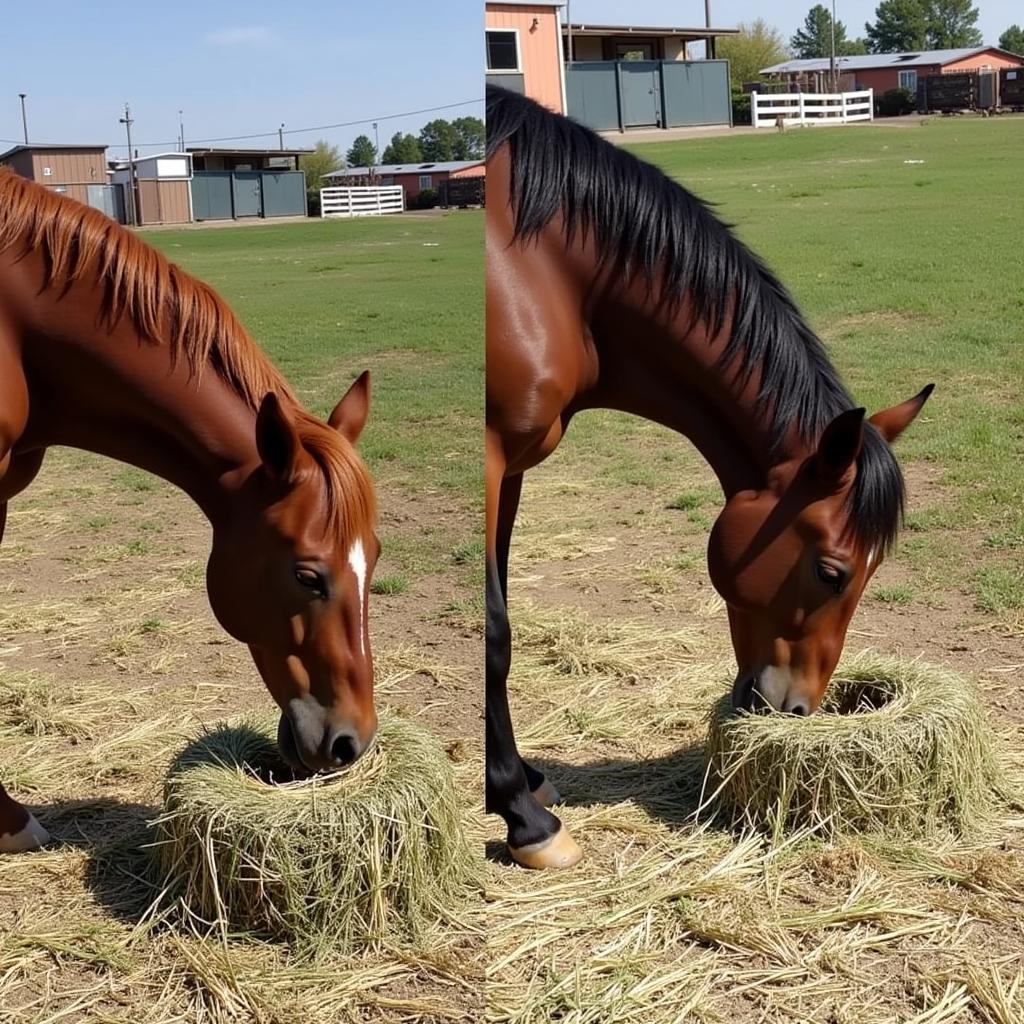Hay rings are a common sight in horse stables and pastures, but choosing the right one can significantly impact your horse’s health and well-being. A well-chosen hay ring can minimize waste, encourage natural grazing behaviors, and prevent digestive issues. Let’s delve into the world of hay rings for horses and explore the various factors to consider when making your selection.
Selecting the appropriate hay ring for your horse can be a daunting task, but it is crucial for maintaining their health and reducing hay wastage. Different types of hay rings cater to various needs, whether you’re looking for a stationary option for a stall or a portable one for the pasture.
Types of Hay Rings for Horses
Choosing a hay ring depends on several factors, including your horse’s individual needs, your budget, and your management style. Here’s a breakdown of the common types of hay rings:
-
Metal Hay Rings: These are a popular choice due to their durability and ease of cleaning. They are available in various sizes and designs, from simple rings to more elaborate feeders with built-in slow-feed mechanisms.
-
Rubber Hay Rings: Rubber rings are known for their safety. They are less likely to cause injury compared to metal rings, making them a good option for young or boisterous horses.
-
Plastic Hay Rings: These are lightweight and generally less expensive than metal or rubber options. However, they may not be as durable, especially in extreme weather conditions.
-
Slow Feed Hay Nets: While not technically rings, these nets are excellent for slowing down consumption and prolonging feeding time, mimicking natural grazing behaviors. They can be hung in stalls or on fences.
Factors to Consider When Choosing a Hay Ring for Horses
Choosing the right hay ring isn’t a one-size-fits-all approach. Consider these essential factors to ensure you make the best choice for your equine companion.
Size and Capacity
The size of the hay ring should be appropriate for the amount of hay you typically feed. A ring that’s too small will result in wasted hay as the horse pulls it out and tramples it. A ring that’s too large can be cumbersome and difficult to manage.
Material and Durability
As discussed earlier, hay rings come in various materials, each with its pros and cons. Metal is durable but can be a safety hazard, while rubber is safer but might not last as long. Consider your horse’s temperament and your budget when choosing the material.
Placement and Stability
Where will you place the hay ring? Will it be in a stall, in a pasture, or both? A stable hay ring requires a solid base, while a pasture ring should be easily movable. Some rings are designed to be hung, while others sit on the ground.
Ease of Cleaning and Maintenance
Regular cleaning is essential to prevent the buildup of bacteria and mold. Choose a hay ring that is easy to clean and maintain.
Benefits of Using a Hay Ring for Horses
Using a hay ring offers a number of benefits for both horse and owner:
-
Reduces Hay Waste: Hay rings prevent horses from scattering hay on the ground, where it becomes soiled and inedible. This can significantly reduce your hay bill. You might also consider a hay bale ring for horses for larger quantities.
-
Promotes Natural Grazing Behavior: Elevated hay rings encourage horses to eat with their heads down, which is their natural grazing posture. This can help prevent respiratory problems.
-
Improves Digestive Health: By slowing down consumption, hay rings can help prevent colic and other digestive issues.
 Benefits of Using a Hay Ring for Horses
Benefits of Using a Hay Ring for Horses
Conclusion
Choosing the right Hay Ring For Horses is a crucial aspect of responsible horse ownership. By considering factors like size, material, placement, and ease of cleaning, you can ensure your horse’s well-being and minimize hay waste. A proper hay ring promotes natural grazing behaviors, improves digestive health, and ultimately contributes to a happy and healthy horse. Remember to always consult with your veterinarian or equine professional for personalized advice. Keeping your horses in autumn requires special attention to their diet, and a hay ring can be a valuable tool.
FAQ
- What size hay ring is best for my horse?
- What are the different types of hay rings available?
- How do I clean a hay ring?
- Can I use a hay net instead of a hay ring?
- Where should I place a hay ring in my horse’s stall?
- What material is best for a hay ring?
- How do I prevent my horse from getting its legs caught in a hay ring?
Common Scenarios
- Scenario 1: Horse is wasting a lot of hay with a current setup.
- Scenario 2: Horse is developing respiratory problems.
- Scenario 3: Looking for a durable and safe hay ring for a young horse.
Further Reading
You might also find these articles helpful: insulated buckets for horses, angular limb deformity horse, kelly quarter horses.
For further assistance, please contact us: Phone: 0772127271, Email: [email protected] or visit us at QGM2+WX2, Vị Trung, Vị Thuỷ, Hậu Giang, Việt Nam. We have a 24/7 customer support team.